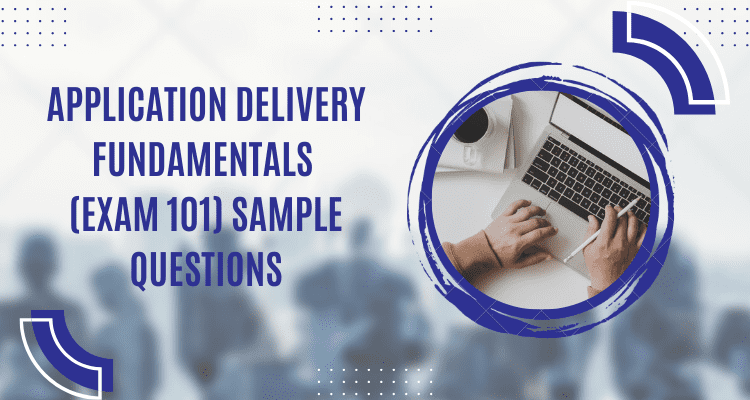Application Delivery Fundamentals (Exam 101) Sample Questions

The Application Delivery Fundamentals (Exam 101) exam measures candidates’ proficiency in the knowledge and abilities needed for managing Application Delivery Networks on a daily basis (ADNs). Candidates who pass this exam will be well-versed in the information needed to work with F5 products and technology. The article provides a list of Application Delivery Fundamentals (Exam 101) Sample Questions that cover core exam topics including –
- Section1: OSI
- Section2: F5 Solutions and Technology
- Section 3: Load Balancing Essentials Cognitive
- Section 4: Security Cognitive
- Section 5: Application Delivery Platforms Cognitive
Q1)Which two sorts of access can users be granted by access policies set up by APM administrators?
- A. CIFS access
- B. Client/server access
- C. Web application access
- D. Proxy access
- E. RDC access
Correct Answer: D
Q2)Which benefit of utilizing iRules is true?
- A. They provide a secure connection between a client and LTM
- B. They enable granular control of traffic
- C. They can be used as templates for creating new applications
- D. They can use Active Directory to authenticate and authorize users
- E. They provide an automated way to create LTM objects
Correct Answer: B
Q3)Which two OSI levels offer access control lists via APM? (Select two.)
- A. Layer 5
- B. Layer 4
- C. Layer 7
- D. Layer 6
- E. Layer 2
Correct Answer: B and C
Q4)The BIG-IP platform uses the F5 software module TMOS.
- A. True
- B. False
Correct Answer: B
Q5)What four F5 products are supported by TMOS? (Select four.)
- A. ARX
- B. GTM
- C. WOM
- D. APM
- E. ASM
- F. Firepass
Correct Answer: B,C, D and E
Q6)Which of the following doesn’t qualify as a BIG-IP profile type?
- A. Protocol
- B. Application
- C. Persistence
- D. Authentication
- E. SSL
Correct Answer: B
Q7)The BIG-IP chooses the connection speed that is least expensive between the client and the server, and utilises it for both connections.
- A. True
- B. False
Correct Answer: B
Q8)TCP multiplexing is another name for the F5 OneConnect functionality.
- A. True
- B. False
Correct Answer: A
Q9)On what programming language is F5 iRules built?
- A. Lisp
- B. C++
- C. Java
- D. TCL
- E. AWK
Correct Answer: D
Q10)Which two techniques are most frequently used to integrate a BIG-IP device into a network environment? (Select two.)
- A. Channeled configuration
- B. VLAN configuration
- C. NAT configuration
- D. SNAT configuration
- E. Asymmetric configuration
- F. Routed configuration
Correct Answer: D and F
Q11)Which of the following advantages of SSL offloading is FALSE?
- A. It broadens the communication channel between the client and LTM.
- B. A pool member can receive communication that has been decrypted, examined, and then re-encrypted by LTM.
- C. The company needs a lot fewer SSL certificates.
- D. The backend servers’ CPU workload is lessened.
- E. It permits the usage of iRules on encrypted communication entering LTM.
Correct Answer: A
Q12)LTM and TCP Express have distinct licenses. True or False
- A. True
- B. False
Correct Answer: B
Q13)Which of these two claims regarding OneConnect is accurate? (Select two.)
- A. The CPU strain on LTM is reduced.
- B. It combines several client connections into one server connection.
- C. The volume of traffic between many clients and LTM is reduced
- D. Configuring SNAT is necessary.
- E. It lessens the CPU load on pool participants.
Correct Answer: B and E
Q14)Which three of these common DNS restrictions does GTM resolve? (Select three.)
- A. Before resolving a host name for a client, it can make sure the host is available.
- B. It can use HTTPS to establish a connection with the client.
- C. It can guarantee that customers continue to use stateful apps at the same data centre.
- D. Before providing the IP address, it can make sure the client is free of malware.
- E. It uses more sophisticated load balancing techniques.
Correct Answer: A, C and E
Q15)An enterprise can always point a client request from France to a datacenter in Dublin using IP Geolocation.
- A. True
- B. False
Correct Answer: A
Q16)On a BIG-IP device, which three of these software modules can be layered on top of LTM? (Select three.)
- A. Web Accelerator
- B. APM
- C. ARX
- D. GTM
- E. Firepass
- F. Enterprise Manager
Correct Answer: A, B and D
Q17)Customers can buy LTM as a standalone solution or layer it with other software modules to expand the BIG-IP device’s functionality.
- A. True
- B. False
Correct Answer: A
Q18)When the pool is overloaded or none of the members are available, which two of the following two choices can LTM use?
- A. Floating IPs
- B. Fallback host
- C. Auto last hop
- D. SNAT automap
- E. Pool offload
- F. Priority group activation
Correct Answer: D
Q19)A CNAME record is used by a top-level DNS zone to direct traffic to a sub-zone. Which of the following is a sub-zone example?
- A. www.F5.com/sub
- B. www.F5.com
- C. www.gslb.F5.com
- D. .com
- E. f5.com
Correct Answer: C
Q20)Which three of the following must be completed for GTM and LTM to effectively communicate? (Select three.)
- A. A network crossover wire should be used to link the GTM and LTM.
- B. Coordinate the GTM and LTM versions of big3d.
- C. Include the LTM object in the configuration of the GTM.
- D. Set up the GTM and LTM to use MAC-masked communication.
- E. Ensure that the floating IP address used by GTM and LTM is the same.
- F. The two devices should trade SSL certificates.
Correct Answer: B, C, and F

